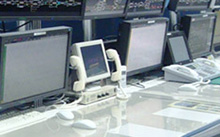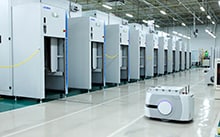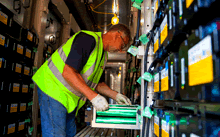In Japan, a shift in energy policy is accelerating the introduction of large amounts of energy from renewable sources such as wind and solar power. In order to stabilize the supply of such environmentally driven renewable energy for island regions, Hitachi is working on the commercialization of safe and economical battery storage systems.
In Japan, a shift in energy policy is accelerating the utilization of energy from renewable sources such as wind and solar power.
However, a new problem has surfaced. Bringing large amounts of energy from renewable sources into the grid tends to destabilize the power supply due to fluctuations of renewable energy.
Providing a stable supply of power is a constant balancing act. When supply and demand do not match, it causes fluctuations in frequency. Normally, utility companies are controlling to keep fluctuations in frequency down to less than 0.2 Hz, as greater fluctuation would have negative effects on control systems and sensitive devices. If the fluctuation becomes greater than several Hz, generators in power plants would stop working, causing greater effects that could destabilize the power supply. The output of power from renewable sources fluctuates with changing weather conditions. Therefore, introducing large amounts of renewable energy to the grid can throw off the balance between supply and demand as well as cause fluctuations in frequency that could destabilize the entire system.
To resolve this problem, Hitachi has been working on the development of battery energy storage systems. It has been making progress on projects inside and outside of Japan, including a demonstration project in Hawaii. Since 2011, Hitachi has also been participating with evident success in the project to develop technology for safe and economical large-scale energy storage systems supported by NEDO (The New Energy and Industrial Technology Development Organization).
Battery energy storage systems have been gaining popularity, but there are many problems to solve. Basically, there are two different kinds of fluctuation in frequency: short cycle and long cycle. Battery energy storage systems need to be able to work with both. In addition to being safe, systems used by utility companies must also have a long life. It is also important to lower costs to be able to popularize their use.
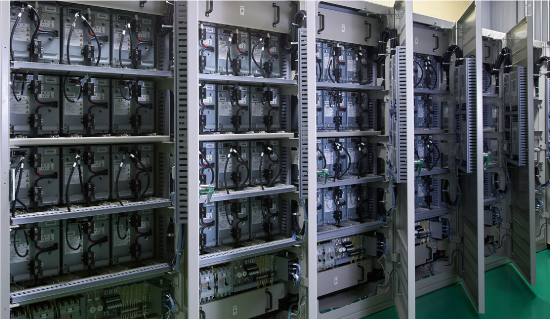
Lithium-ion capacitors are effective in addressing short-cycle frequency fluctuations.
To achieve these goals, Hitachi conceived of the development of a new hybrid battery energy storage system that combines lead-acid batteries and lithium-ion capacitors.
Lead-acid batteries used in industrial applications have large capacity and endurance, but they are not suited to absorb short-cycle fluctuations. On the other hand, lithium-ion capacitors have high-power output capability to respond short-cycle fluctuations, but their capacity is small and not suited for long-cycle fluctuations. That's why Hitachi decided to combine the strengths of both systems to be able to deal with both long-cycle and short-cycle fluctuation.
The development goal is to cover the same frequency control range as variable-speed, pumped-storage hydroelectric plants. For this purpose, Hitachi co-developed a 1.5 MW hybrid battery energy storage system with a group company, Shin-Kobe Electric Machinery Co., Ltd. (now Hitachi Chemical Company, Ltd.), as part of a project subsided by NEDO.
In cooperation with TEPCO* Power Grid, Inc., Hitachi has been conducting a demonstration project for its hybrid battery energy storage system on Izu Oshima Island, south of Tokyo. This island was selected for its independent power grid, which makes it a suitable testing site to assess the effect of introducing large amounts of energy from renewable sources on the grid.
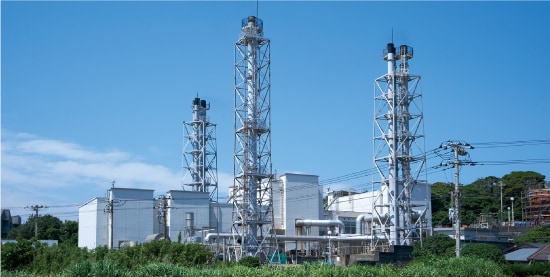
Diesel power plant by TEPCO Power Grid, Inc.
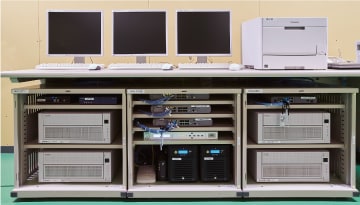
Control system used to monitor the battery energy storage system in the demonstration project.
In the demonstration project, which is aiming toward the commercialization of the system, the durability of the battery energy storage system was an especially important concern. Hitachi Chemical Company, Ltd., the developer of the lead batteries, has more than 10 years' experience in delivering devices to reduce power fluctuation. The company has been researching and analyzing batteries for longevity and has accumulated a knowledge base on the improvement of battery performance. In the Izu Oshima Island demonstration, Hitachi has also evaluating the durability and performance of the battery energy storage system through deterioration analysis utilizing data from Hitachi Chemical Company, Ltd. Further, Hitachi is creating control systems to monitor the operational status of the battery energy storage system for the demonstration project, not just for onsite monitoring but also for remote monitoring from the TEPCO's Oshima Power Plant at Izu Oshima Island in Tokyo and Hitachi's Omika Works in Ibaraki Prefecture. Hitachi is striving to develop control technology from research and analysis of the data for the operation of battery energy storage systems.
As Izu Oshima Island has been relying on diesel power generation, one of the purposes of this demonstration project is to evaluate the effect of using the battery energy storage system to reduce fuel costs via decreased combustion. Hitachi is looking to find economical solutions to improve power grids in other island regions that have been relying on fossil fuels for their power supply. Hitachi is working towards optimal utilization of renewable energy and diesel power generation.
The demonstration project in Izu Oshima Island that began in 2015 has entered a new phase as a joint research project with TEPCO Power Grid, Inc. The companies have been evaluating the efficacy of the monitoring control system and its effects on the operation of existing power plants. Hitachi is aiming for the commercialization of the system by 2018 to contribute to stabilizing the supply of power in island regions.
In addition to Izu Oshima Island, Japan has many other regions with small islands that have independent power grids. In order to introduce more renewable energy to take advantage of island climates, it is essential to have measures in place to deal with fluctuations in output related to weather. Hitachi will continue to strive to commercialize safe and economical battery energy storage systems that can stabilize of the supply of power in island regions and to provide solutions for social issues stemming from the large-scale introduction of energy from renewable sources.

Hitachi is contributing to stable electric supply throughout the island regions.
Release Date: September 2016
Solutions By: Energy Solutions Business Unit, Hitachi, Ltd.




